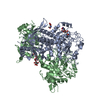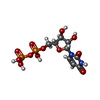+ Open data
Open data
- Basic information
Basic information
| Entry | Database: PDB / ID: 7zay | |||||||||||||||||||||||||||||||||||||||||||||||||||
|---|---|---|---|---|---|---|---|---|---|---|---|---|---|---|---|---|---|---|---|---|---|---|---|---|---|---|---|---|---|---|---|---|---|---|---|---|---|---|---|---|---|---|---|---|---|---|---|---|---|---|---|---|
| Title | Human heparan sulfate polymerase complex EXT1-EXT2 | |||||||||||||||||||||||||||||||||||||||||||||||||||
 Components Components |
| |||||||||||||||||||||||||||||||||||||||||||||||||||
 Keywords Keywords | TRANSFERASE / Heparan sulfate biosynthesis / Enzyme complex / Glycosyltransferase / Golgi | |||||||||||||||||||||||||||||||||||||||||||||||||||
| Function / homology |  Function and homology information Function and homology informationglucuronosyl-N-acetylglucosaminyl-proteoglycan 4-alpha-N-acetylglucosaminyltransferase / N-acetylglucosaminyl-proteoglycan 4-beta-glucuronosyltransferase / hypersensitivity / heart field specification / lymphocyte adhesion to endothelial cell of high endothelial venule / heparan sulfate N-acetylglucosaminyltransferase activity / glucuronosyl-N-acetylglucosaminyl-proteoglycan 4-alpha-N-acetylglucosaminyltransferase activity / N-acetylglucosaminyl-proteoglycan 4-beta-glucuronosyltransferase activity / smoothened signaling pathway involved in lung development / developmental growth involved in morphogenesis ...glucuronosyl-N-acetylglucosaminyl-proteoglycan 4-alpha-N-acetylglucosaminyltransferase / N-acetylglucosaminyl-proteoglycan 4-beta-glucuronosyltransferase / hypersensitivity / heart field specification / lymphocyte adhesion to endothelial cell of high endothelial venule / heparan sulfate N-acetylglucosaminyltransferase activity / glucuronosyl-N-acetylglucosaminyl-proteoglycan 4-alpha-N-acetylglucosaminyltransferase activity / N-acetylglucosaminyl-proteoglycan 4-beta-glucuronosyltransferase activity / smoothened signaling pathway involved in lung development / developmental growth involved in morphogenesis / sweat gland development / perichondral bone morphogenesis / mesenchymal cell differentiation involved in bone development / response to leukemia inhibitory factor / UDP-N-acetylglucosamine transferase complex / chondrocyte hypertrophy / embryonic skeletal joint development / hematopoietic stem cell migration to bone marrow / fluid transport / tight junction organization / glucuronosyltransferase activity / limb joint morphogenesis / Defective EXT2 causes exostoses 2 / Defective EXT1 causes exostoses 1, TRPS2 and CHDS / heparin proteoglycan biosynthetic process / sebaceous gland development / glomerular basement membrane development / response to heparin / stomach development / glycosaminoglycan biosynthetic process / HS-GAG biosynthesis / glandular epithelial cell differentiation / lymphocyte migration into lymphoid organs / sulfation / chondrocyte proliferation / dendritic cell migration / endochondral bone morphogenesis / dendrite self-avoidance / heparan sulfate proteoglycan biosynthetic process / acetylglucosaminyltransferase activity / endochondral bone growth / podocyte differentiation / hematopoietic stem cell homeostasis / cartilage development involved in endochondral bone morphogenesis / sodium ion homeostasis / basement membrane organization / vocalization behavior / olfactory bulb development / endochondral ossification / vacuole organization / cranial skeletal system development / multicellular organismal-level water homeostasis / endoderm development / leukocyte tethering or rolling / fear response / polysaccharide biosynthetic process / response to light intensity / optic nerve development / protein N-linked glycosylation / regulation of tumor necrosis factor-mediated signaling pathway / collagen fibril organization / ossification involved in bone maturation / cell adhesion mediated by integrin / neural crest cell differentiation / hair follicle morphogenesis / stem cell division / : / heart contraction / antigen processing and presentation / epithelial tube branching involved in lung morphogenesis / glycosyltransferase activity / mesoderm development / motor behavior / mesoderm formation / blood vessel remodeling / fibroblast growth factor receptor signaling pathway / social behavior / cell fate commitment / hematopoietic stem cell differentiation / chondrocyte differentiation / canonical Wnt signaling pathway / bone resorption / BMP signaling pathway / catalytic complex / cellular response to fibroblast growth factor stimulus / gastrulation / axon guidance / ossification / synaptic transmission, glutamatergic / protein catabolic process / wound healing / cellular response to virus / regulation of blood pressure / vasodilation / multicellular organism growth / protein-containing complex assembly / gene expression / protein heterodimerization activity / Golgi membrane / synapse Similarity search - Function | |||||||||||||||||||||||||||||||||||||||||||||||||||
| Biological species |  Homo sapiens (human) Homo sapiens (human) | |||||||||||||||||||||||||||||||||||||||||||||||||||
| Method | ELECTRON MICROSCOPY / single particle reconstruction / cryo EM / Resolution: 2.8 Å | |||||||||||||||||||||||||||||||||||||||||||||||||||
 Authors Authors | Leisico, F. / Omeiri, J. / Hons, M. / Schoehn, G. / Lortat-Jacob, H. / Wild, R. | |||||||||||||||||||||||||||||||||||||||||||||||||||
| Funding support |  France, 3items France, 3items
| |||||||||||||||||||||||||||||||||||||||||||||||||||
 Citation Citation |  Journal: Nat Commun / Year: 2022 Journal: Nat Commun / Year: 2022Title: Structure of the human heparan sulfate polymerase complex EXT1-EXT2. Authors: Francisco Leisico / Juneina Omeiri / Christine Le Narvor / Joël Beaudouin / Michael Hons / Daphna Fenel / Guy Schoehn / Yohann Couté / David Bonnaffé / Rabia Sadir / Hugues Lortat-Jacob / Rebekka Wild /  Abstract: Heparan sulfates are complex polysaccharides that mediate the interaction with a broad range of protein ligands at the cell surface. A key step in heparan sulfate biosynthesis is catalyzed by the bi- ...Heparan sulfates are complex polysaccharides that mediate the interaction with a broad range of protein ligands at the cell surface. A key step in heparan sulfate biosynthesis is catalyzed by the bi-functional glycosyltransferases EXT1 and EXT2, which generate the glycan backbone consisting of repeating N-acetylglucosamine and glucuronic acid units. The molecular mechanism of heparan sulfate chain polymerization remains, however, unknown. Here, we present the cryo-electron microscopy structure of human EXT1-EXT2, which reveals the formation of a tightly packed hetero-dimeric complex harboring four glycosyltransferase domains. A combination of in vitro and in cellulo mutational studies is used to dissect the functional role of the four catalytic sites. While EXT1 can catalyze both glycosyltransferase reactions, our results indicate that EXT2 might only have N-acetylglucosamine transferase activity. Our findings provide mechanistic insight into heparan sulfate chain elongation as a nonprocessive process and lay the foundation for future studies on EXT1-EXT2 function in health and disease. | |||||||||||||||||||||||||||||||||||||||||||||||||||
| History |
|
- Structure visualization
Structure visualization
| Structure viewer | Molecule:  Molmil Molmil Jmol/JSmol Jmol/JSmol |
|---|
- Downloads & links
Downloads & links
- Download
Download
| PDBx/mmCIF format |  7zay.cif.gz 7zay.cif.gz | 252.5 KB | Display |  PDBx/mmCIF format PDBx/mmCIF format |
|---|---|---|---|---|
| PDB format |  pdb7zay.ent.gz pdb7zay.ent.gz | 191.8 KB | Display |  PDB format PDB format |
| PDBx/mmJSON format |  7zay.json.gz 7zay.json.gz | Tree view |  PDBx/mmJSON format PDBx/mmJSON format | |
| Others |  Other downloads Other downloads |
-Validation report
| Summary document |  7zay_validation.pdf.gz 7zay_validation.pdf.gz | 1.3 MB | Display |  wwPDB validaton report wwPDB validaton report |
|---|---|---|---|---|
| Full document |  7zay_full_validation.pdf.gz 7zay_full_validation.pdf.gz | 1.3 MB | Display | |
| Data in XML |  7zay_validation.xml.gz 7zay_validation.xml.gz | 50.1 KB | Display | |
| Data in CIF |  7zay_validation.cif.gz 7zay_validation.cif.gz | 74.5 KB | Display | |
| Arichive directory |  https://data.pdbj.org/pub/pdb/validation_reports/za/7zay https://data.pdbj.org/pub/pdb/validation_reports/za/7zay ftp://data.pdbj.org/pub/pdb/validation_reports/za/7zay ftp://data.pdbj.org/pub/pdb/validation_reports/za/7zay | HTTPS FTP |
-Related structure data
| Related structure data |  14582MC M: map data used to model this data C: citing same article ( |
|---|---|
| Similar structure data | Similarity search - Function & homology  F&H Search F&H Search |
- Links
Links
- Assembly
Assembly
| Deposited unit | 
|
|---|---|
| 1 |
|
- Components
Components
| #1: Protein | Mass: 85261.859 Da / Num. of mol.: 1 Source method: isolated from a genetically manipulated source Source: (gene. exp.)  Homo sapiens (human) / Gene: EXT1 / Cell line (production host): Freestyle 293-F / Production host: Homo sapiens (human) / Gene: EXT1 / Cell line (production host): Freestyle 293-F / Production host:  Homo sapiens (human) Homo sapiens (human)References: UniProt: Q16394, glucuronosyl-N-acetylglucosaminyl-proteoglycan 4-alpha-N-acetylglucosaminyltransferase, N-acetylglucosaminyl-proteoglycan 4-beta-glucuronosyltransferase |
|---|---|
| #2: Protein | Mass: 79056.836 Da / Num. of mol.: 1 Source method: isolated from a genetically manipulated source Source: (gene. exp.)  Homo sapiens (human) / Gene: EXT2 / Cell line (production host): Freestyle 293-F / Production host: Homo sapiens (human) / Gene: EXT2 / Cell line (production host): Freestyle 293-F / Production host:  Homo sapiens (human) Homo sapiens (human)References: UniProt: Q93063, glucuronosyl-N-acetylglucosaminyl-proteoglycan 4-alpha-N-acetylglucosaminyltransferase, N-acetylglucosaminyl-proteoglycan 4-beta-glucuronosyltransferase |
| #3: Polysaccharide | beta-D-mannopyranose-(1-4)-2-acetamido-2-deoxy-beta-D-glucopyranose-(1-4)-2-acetamido-2-deoxy-beta- ...beta-D-mannopyranose-(1-4)-2-acetamido-2-deoxy-beta-D-glucopyranose-(1-4)-2-acetamido-2-deoxy-beta-D-glucopyranose Source method: isolated from a genetically manipulated source |
| #4: Sugar | ChemComp-NAG / |
| #5: Chemical | ChemComp-UDP / |
| Has ligand of interest | Y |
| Has protein modification | Y |
-Experimental details
-Experiment
| Experiment | Method: ELECTRON MICROSCOPY |
|---|---|
| EM experiment | Aggregation state: PARTICLE / 3D reconstruction method: single particle reconstruction |
- Sample preparation
Sample preparation
| Component | Name: Hetero-dimeric complex EXT1-EXT2 / Type: COMPLEX Details: local resolution-filtered map generated using a B-factor of -30 A2 Entity ID: #1-#2 / Source: RECOMBINANT |
|---|---|
| Molecular weight | Value: 0.16 MDa / Experimental value: YES |
| Source (natural) | Organism:  Homo sapiens (human) Homo sapiens (human) |
| Source (recombinant) | Organism:  Homo sapiens (human) / Cell: Freestyle 293-F Homo sapiens (human) / Cell: Freestyle 293-F |
| Buffer solution | pH: 7.2 |
| Specimen | Conc.: 0.4 mg/ml / Embedding applied: NO / Shadowing applied: NO / Staining applied: NO / Vitrification applied: YES Details: Purified EXT1-EXT2 complex at 0.4mg/mL was mixed with 1mM of UDP-GlcNAc, 1mM UDP-GlcA and 1mM MnCl2 and incubated 15 min on ice before applying 4 uL of the sample onto a glow discharged ...Details: Purified EXT1-EXT2 complex at 0.4mg/mL was mixed with 1mM of UDP-GlcNAc, 1mM UDP-GlcA and 1mM MnCl2 and incubated 15 min on ice before applying 4 uL of the sample onto a glow discharged Quantifoil holey carbon grid (R1.2/1.3, 300 mesh, copper). |
| Specimen support | Grid material: COPPER / Grid type: Quantifoil R1.2/1.3 |
| Vitrification | Instrument: FEI VITROBOT MARK IV / Cryogen name: ETHANE / Humidity: 100 % / Chamber temperature: 277 K |
- Electron microscopy imaging
Electron microscopy imaging
| Experimental equipment |  Model: Titan Krios / Image courtesy: FEI Company |
|---|---|
| Microscopy | Model: FEI TITAN KRIOS |
| Electron gun | Electron source:  FIELD EMISSION GUN / Accelerating voltage: 300 kV / Illumination mode: OTHER FIELD EMISSION GUN / Accelerating voltage: 300 kV / Illumination mode: OTHER |
| Electron lens | Mode: BRIGHT FIELD / Nominal defocus max: 3000 nm / Nominal defocus min: 1000 nm |
| Image recording | Electron dose: 46 e/Å2 / Film or detector model: GATAN K3 BIOQUANTUM (6k x 4k) |
- Processing
Processing
| Software | Name: PHENIX / Version: 1.20.1_4487: / Classification: refinement | ||||||||||||||||||||||||
|---|---|---|---|---|---|---|---|---|---|---|---|---|---|---|---|---|---|---|---|---|---|---|---|---|---|
| EM software | Name: PHENIX / Category: model refinement | ||||||||||||||||||||||||
| CTF correction | Type: PHASE FLIPPING AND AMPLITUDE CORRECTION | ||||||||||||||||||||||||
| 3D reconstruction | Resolution: 2.8 Å / Resolution method: FSC 0.143 CUT-OFF / Num. of particles: 286390 / Symmetry type: POINT | ||||||||||||||||||||||||
| Refine LS restraints |
|
 Movie
Movie Controller
Controller



 PDBj
PDBj







